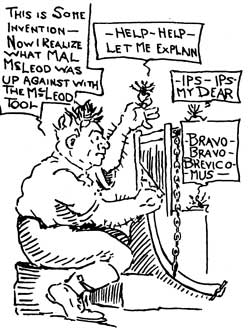Bill Godfrey was particularly well liked by the entomologists and some time during his earlier work with the Forest Service in California he drew an appropriate cartoon of a bark cutting apparatus used for studying bark beetles. I found the cartoon during a search of the files at the Pacific Southwest Forest Research Station in Berkeley in August 1987 (cartoon on page 20).
The year 1931 might best be described as the year the ax fell on Keen’s neck. Keen’s 1931 report of control activities is missing from the files, but according to Frank Solinsky, in charge of Park Service operations, work started on April 30. The Forest Service treated 1,020 trees east of the park. Snow and rain storms in the park lasted from June 13 to June 30, delaying the treatment by the solar-heat method considerably, but helping to ease the drought conditions of 1929 and early 1930. With bad weather and all, Solinsky reported 14,747 trees cut in the park that season. Solinsky continues, “In the last three years we have spent over $33,000 and cut 48,238 trees.” [24] Solinsky was pessimistic about ever winning the battle unless a complete cleanup of the control units was done. Further, he recommended stopping the control efforts unless this approach was followed. Solinsky also mentions that W. Buckhorn of the Bureau of Entomology spent the whole season in the park helping on the control work (see footnote 24).
Walter J. Buckhorn started working for the Division of Forest Insect Investigations, Bureau of Entomology, in 1925. His earliest assignment was assisting F.P. Keen in spotting and mapping beetle-killed pine on the southern Oregon-northern California project. In 1930, he was given the task of surveying the infested areas of the park under Keen. He went on to a distinguished career as an entomologist in the Bureau of Entomology Portland laboratory. He was awarded the U.S. Department of Agriculture’s Superior Service Award in 1956 for vision and leadership in pioneering and developing forest insect aerial surveys in Oregon and Washington. Buckhorn was a versatile and competent entomologist who came up through the ranks. He was a good-humored field companion who eased the rougher spots according to Keen. He was bitten by the flying bug; he resigned from the Bureau for a short time in the mid 1920s to attend an airplane mechanics school and attempted to start his own flying service. His continued interest in flying after he returned to Government service resulted in his development of the aerial survey techniques that led to his Department award. He retired from the Forest Service in 1962 after 37 years of Government service. He died in Portland, Oregon, on November 9, 1968. [25]


